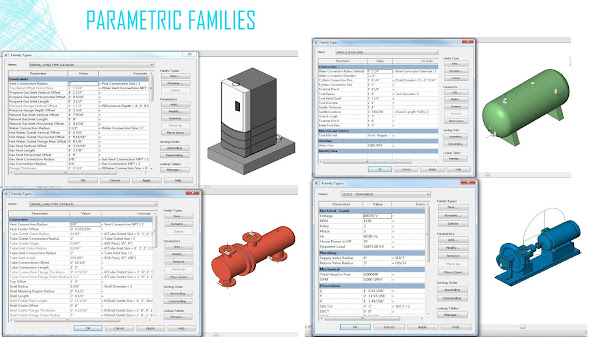Revit Family Creation: The Building Block of Effective BIM Content Creation
Building Information Modeling (BIM) has revolutionized the construction industry by allowing architects, engineers, and builders to create 3D models of buildings and structures that can be analyzed, shared, and collaborated on in real-time. BIM software, such as Autodesk Revit, has become an essential tool for the construction industry due to its ability to create accurate and detailed models that simulate the entire building lifecycle. However, the effectiveness of BIM depends on the quality of the content created within the software. Revit Family Creation is the building block of effective BIM Content Creation Services, and this article will explore the importance of creating high-quality Revit Families and the benefits they provide to the construction industry.
What are Revit Families?
Revit Families are components that make up the 3D Models created within Revit. These components can be anything from walls and doors to furniture and lighting fixtures. A Revit Family is a parametric object that has a set of properties, dimensions, and constraints that can be modified to create variations of the object. A well-crafted Revit Family can save time, increase productivity, and reduce errors throughout the design process.
Why are Revit Families Important?
Revit Families are essential components of effective BIM content creation. They allow architects, engineers, and builders to create accurate and detailed models of buildings and Structural BIM that can be analyzed, shared, and collaborated on in real-time.
Revit Families also provide several benefits to the construction industry, including:
- Consistency: Revit Families allow for consistent design standards throughout the project. They provide a set of properties, dimensions, and constraints that can be used to create variations of the object. This ensures that all objects created within the project are consistent in terms of size, shape, and properties.
- Efficiency: Revit Families can save time and increase productivity by allowing designers to reuse components across multiple projects. This reduces the need to recreate objects from scratch, which can be time-consuming and prone to errors.
- Accuracy: Revit Families ensure that objects are accurate and precise. They provide a set of properties, dimensions, and constraints that ensure that the object is created to the required specifications. This reduces errors and ensures that the object is fit for purpose.
- Flexibility: Revit Families provide the flexibility to create custom objects that meet specific project requirements. They allow designers to modify properties, dimensions, and constraints to create variations of the object. This ensures that the object meets the project's requirements while maintaining consistency with other objects within the project.
How to Create Effective Revit Families?
Creating effective Revit Families requires a thorough understanding of the software's capabilities and the project's requirements.
The following are some tips for creating effective Revit Families:
Understand the Project Requirements: Before creating a Revit Family, it is essential to understand the project's requirements. This includes the object's purpose, size, shape, and properties. Understanding the project's requirements ensures that the object meets the project's needs.
Follow Best Practices: Creating Revit Families requires following best practices. This includes using appropriate naming conventions, organizing the object's properties, and using consistent units of measurement.
Use Parameters: Revit Families use parameters to control the object's properties, dimensions, and constraints. Using parameters provides flexibility and ensures that the object meets the project's requirements.
Test and Refine: Creating effective Revit Families requires testing and refining the object. This includes ensuring that the object meets the project's requirements, is accurate, and can be reused across multiple projects.
In today's fast-paced construction industry, BIM automation services have become increasingly important to help designers create high-quality Revit Families quickly and efficiently. BIM automation services can help streamline the Revit Family Creation process, reduce errors, and improve collaboration across the construction industry. By using BIM automation services, designers can focus on the creative aspects of Revit Family Creation, while the software takes care of repetitive tasks, such as parameter creation, family placement, and family customization.
Moreover, BIM Automation Services can also help ensure that Revit Families meet specific project requirements by automating the creation of custom families that are tailored to the project's needs. This can help designers save time and reduce errors while creating families that are flexible enough to be reused across multiple projects.
In addition to BIM automation services, it is important to follow best practices when creating Revit Families to ensure that they are consistent, accurate, and easy to use. This includes using appropriate naming conventions, organizing the object's properties, and using consistent units of measurement. By following these best practices, designers can ensure that their Revit Families are easy to understand and modify, reducing errors and saving time.
BIM automation services have become essential tools for designers looking to create high-quality Revit Families quickly and efficiently. By understanding the software's capabilities, project requirements, and following best practices, designers can create custom Revit Families that meet specific project needs and can be reused across multiple projects. BIM automation services can help streamline the Revit Family Creation process, reduce errors, and improve collaboration across the construction industry, making them an invaluable resource for any design team.
Conclusion:
The article discusses the importance of Revit Family Creation as the building block of effective BIM content creation. It emphasizes the need for designers to have a thorough understanding of the software's capabilities and project requirements, as well as the importance of following best practices when creating Revit Families. Additionally, the article highlights the significance of BIM automation services in streamlining the Revit Family Creation process, reducing errors, and improving collaboration across the construction industry. By understanding the software, following best practices, and utilizing BIM automation services, designers can create high-quality Revit Families that are accurate, flexible, and easy to use.





Comments
Post a Comment